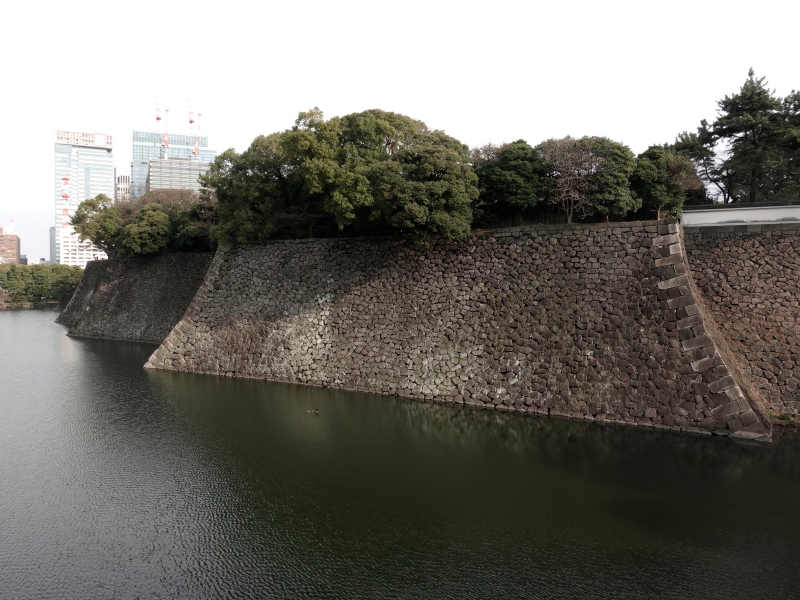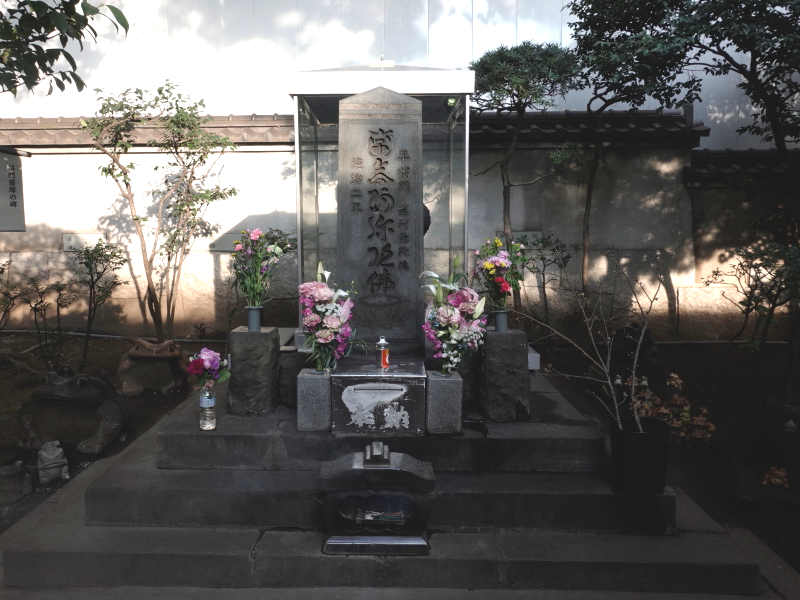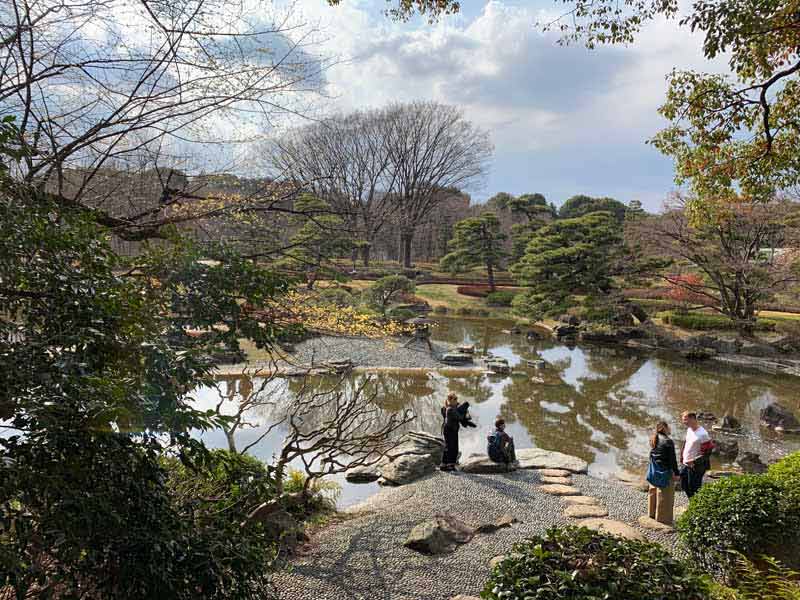Hi! I’m YUKORIN. I am a wheelchair user. On March 17th, our Accessible members carried out our first wheelchair accessibility review in 2019 at the East Gardens of the Imperial Palace. The Imperial Palace was built on the historical site of the former Edo Palace which was constructed in the Edo Period. Their Majesties the Emperor and Empress now reside in the Imperial Palace. The East Gardens of the Imperial Palace is open to the public as the gardens belonging to the palace.

The Imperial Palace
We met at a building located across the avenue from the Marunouchi side of Tokyo Station. Passing by the Marunouchi Central Square, we headed for the East Gardens of the Imperial Palace.

Tokyo Station
We walked on the Gyoko-dori Avenue that was once the exclusive avenue for horse carriages of the Imperial family which went to Tokyo Station. I found it easy to walk along the very wide avenue on a wheelchair.

The Gyoko-dori Avenue
Wadakura Fountain Park
We arrived at the Wadakura Fountain Park. It is located within 10 minutes’ walk from the Marunouchi side of Tokyo Station. This park is the first spot of our wheelchair accessibility review. A splendid fountain!

The Wadakura Fountain Park
We entered the park from the Gyoko-dori Avenue. But you can also enter by crossing the Wadakura bridge.

The Wadakura bridge
A gentle ramp is installed at the park.

The ramp at the park
We checked a multipurpose restroom. It is not so clean in spite of being spacious enough.

The multipurpose restroom at the Wadakura Fountain Park
Let me try to cross the Wadakura bridge just because we visited the park. Although the path between the park and the bridge is covered with gravel, I could walk along part of the gravel path which is firmly fixed on the ground like asphalt.

The part of the gravel path is firmly fixed on the ground.
The ground of the Wadakura bridge is covered with gravel too. However, wheelchair users have no problem in crossing the bridge as the gravel is minuscule.

The ground of the Wadakura bridge
I got back to the park. There is a bridge across a canal from the fountain rivers. And ramps are built on both sides of the bridge.

One ramp on one side of the bridge
Finish conducting our accessibility check at the park and going right to the East Gardens of the Imperial Palace.

Going to the East Gardens.
The East Gardens of the Imperial Palace
On the way to the garden, there is the Kikyo-mon Gate that is one of the gates of the East Gardens of the Imperial Palace.

The Kikyo-mon Gate
We found a multipurpose restroom at the public restrooms near the Kikyo-mon Gate. It is quite clean and well-equipped. Good!

The multipurpose restroom near the Kikyo-mon Gate
At last we arrived at the Ote-mon Gate of the East Gardens of the Imperial Palace. It would take about 15 minutes to go directly to the garden from the Marunouchi side of Tokyo Station just passing through the Wadakura Fountain Park.

A signboard of the East Gardens of the Imperial Palace
The gate we entered is called the “Ote-mon Gate” which includes the Korai-mon Gate and the Watariyagura-mon Gate. Here is the Korai-mon Gate.

The Korai-mon Gate
We had a security check.

The security check
We found a signboard of a multi-language audio guide app for foreign tourists. Many visitors to the garden seem to be tourists from overseas.

The signboard of the multi-language audio guide app
Here is the Watariyagura-mon Gate. A substantial structure.

The Watariyagura-mon Gate
You get to the ticket office after going through the Watariyagura-mon Gate. By the way, this garden is basically closed on Mondays and Fridays. However, it is open in case a national holiday falls on Monday and it is closed instead on the next day that is Tuesday. You might want to check the closed days in advance of your visit. Also, you can rent up to three wheelchairs free of charge at the Ote-mon Gate and one wheelchair at the Hirakawa-mon Gate respectively. You can rent them on a first come first served basis but you cannot make a booking for them.

The ticket office

A signboard of the ticket office
You receive the admission ticket to enter the garden. You need to return it at the gate where you leave the garden. Please make sure to keep it. Losing it will put you in a very troublesome situation.

The admission ticket
The first place we visited was the Museum of the Imperial Collections named San-no-maru Sho-zo-kan in Japanese. The exhibits are regularly changed on various themes. The poems of Their Majesties the Emperor and Empress were displayed on the day.

The Museum of the Imperial Collections
There is an access ramp at the entrance of the museum.

The ramp at the entrance of the Museum of the Imperial Collection
Here is a multipurpose restroom near the Museum of the Imperial Collection. I found it well-equipped and relatively clean as a restroom in gardens.

The multipurpose restroom near the Museum of the Imperial Collection
We dropped by a resting place with a Kiosk. You can buy soft drinks and soft ice creams here. There are three entrances and an automatic door is equipped only at the main entrance.

The resting place with a Kiosk
Leaving behind the resting place and the Doshin-bansho Guardhouse, we turned right and followed the walkway to the Ninomaru Garden. The most part of walkway in the garden is broad as you can see below.

The broad walkway
We went off the asphalt walkway and then entered the Ninomaru Grove. The atmosphere became like a natural garden.

The Ninomaru Grove
When we got out of the grove, the scenery of the Ninomaru Garden was laid out before our eyes. The Japanese garden is filled with an ambience of refined elegance of nature. Their Majesties the Emperor and Empress sometimes enjoy taking a walk around the garden.

The Ninomaru Garden
We found rock stairs. I’m going to try to climb up as the stairs are pretty gentle!

I’m climbing the stairs on a wheelchair!
stairs.
I admired the panoramic view that I would not able to admire at the lower place. I was impressed with the beautiful scenery.

The panoramic view of the garden
Getting out of the Ninomaru Garden, we passed in front of the Shiomi-zaka slope where wheelchair users have to refrain from going up. This slope is so steep that wheelchair users would not be able to go up and down.

The Shiomi-zaka slope

A signboard saying the slope is too steep for wheelchairs
This is the Hyaku-nin-bansho Guardhouse where 100 guards were stationed in the house in the Edo period. Yama-chan who is one of our members and is familiar with history told us that Ninjas, martial art spies, were stationed there in the early Edo period.

The Hyaku-nin-bansho Guardhouse
The evergreen shrub located next is trimmed into the same shape as the guardhouse. Somewhat cute.

The evergreen shrub trimmed into the same shape as the guardhouse
There are several universally designed benches near the Fujimi-yagura which was a defense tower. You can hold the handrails attached to the bench when you sit down or stand up.

The bench with handrails
Here is the Tea Garden located west of the Honmaru O-shibafu Lawn. We found a signboard saying that the slope is too steep for wheelchairs. I assumed that it would be too dangerous for wheelchair users to walk along the sharp curve on the steep slope.

The signboard at the Tea Garden which says the slope is too steep for wheelchairs
Prunus campanulate which is also called Taiwan cherry was in bloom around the Honmaru O-shibafu Lawn. A kind of cherry trees blooming in the winter. Fantastic!

Prunus campanulate
We checked a multipurpose restroom located next to a resting place near the Honmaru O-shibafu Lawn. It is appropriately spacious and the equipment is okay. I often see this type of multipurpose restroom at public restrooms of parks in Japan.

The multipurpose restroom located next to the resting place
The Tenshu-dai Base of the Main Tower is located within a minute walk from the resting place. Although we would need to climb the quite steep slope to the deck, we found no signboards saying that the slope is too steep for wheelchairs. We didn’t go up to the deck since we didn’t have enough time. But I look forward to trying to go up if I can have a chance to come here again.

The Tenshu-dai Base of the Main Tower
Getting out from the Kita-hane-bashi-mon Gate located northwest of the garden, we wrapped up our wheelchair accessibility review and sightseeing at the East Gardens of the Imperial Palace. You can see a hut on the left side in the picture below. You need to return the admission ticket to a staffer who is stationed in the hut.

The Kita-hane-bashi-mon Gate
We took a walk around the Imperial Palace moat after going out of the garden. A massive moat. We enjoyed the magnificent view where the palace is surrounded with the huge moat.

The Imperial Palace moat
The grave of Taira no Masakado
The last place we visited was the grave of Taira no Masakado. It took 10 to 15 minutes from the Kita-hane-bashi-mon Gate on foot. Taira no Masakado was a samurai who claimed the title of a new emperor by conquering the Kanto region at the Tengyo battle in 939 during the middle of the Heian period of Japanese history.

The monument of Masakado’s grave
There are some stairs to the grave. Our members lifted my wheelchair to the upper ground.

More than 1,000 years has passed since his death. Even today ordinary people like us pay a visit to his grave to trace the history. Feeling the significance of history, I paid reverence toward the great samurai in front of his grave.

The grave of Taira no Masakado

His Majesty the Emperor will abdicate on the 30th of April 2019 and a new imperial era will begin on the 1st of May. Fortunately, we had a chance to visit the East Gardens of the Imperial Palace, which is also the gardens for the Imperial family, when the turning point is coming to put an end of the Heisei imperial era and open a new chapter in Japanese history. Although you can reach the gardens from Tokyo Station within some minutes’ walk, you can feel Japanese culture, history and nature in a tranquil atmosphere. Finding no problems in walking around, I recommend wheelchair users the gardens as a wheelchair accessible sightseeing spot. Various kinds of flowers are going to bloom as spring is coming around. Would you like to have a rest at the East Gardens of the Imperial Palace where you can feel as if you were in an oasis far away from busy Tokyo?


